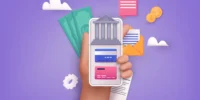An effective debt collection letter can help your client pay his or her debts on time. Using this guide, you will learn how to write a debt collection letter in just a few minutes.
The debt collection letter asks the debtor to pay the debt. In addition, it is possible to inform the debtor of the consequences of not making a payment. After all other collection efforts have failed, a collection letter should be sent.
The letter might be sent to a client who hasn’t paid directly or through a collection agency in the commercial world. A debt collection letter informs the recipient that you are trying to collect a debt from them and that it is their legal responsibility to do so.
In addition, both parties should be provided with contact information so that they can communicate directly over the weekend and outside of regular business hours.
How Are Debt Collection Letters Generally Worded?
The first letter you send to a delinquent customer should be polite, reminding them of their obligation and requesting that they resume payments as soon as possible. Not out of politeness, but because customers sometimes forget to pay or believe they have already paid.
In this case, you should remind them of their financial obligations and request immediate payment. You may be able to assist your customer by offering a discount or payment plan if they have fallen on hard times due to illness or other personal concerns.
As time passes, you continue to receive either no response or no payment. Your debt collection letters should become harsher and warn the customer that they may be subject to legal action if they do not pay. It is often the only way to collect payment from a customer. When people realize you are serious, they will often pay what they owe; otherwise, they may believe you won’t pursue legal action.
Debt Collection Letters: What Are Their Purposes?
Letters sent to creditors to collect debts are called debt collection letters. There are three main purposes of debt collection letters:
Providing debtors with debt information
A debt collection letter is primarily intended to remind debtors of their outstanding balance and original due date. So there is no ambiguity about what is being requested, the letter should include all pertinent debt facts. A debt collection letter should never be sent until the debtor fails to make the first payment on time.
It is often wise to keep your letter cordial and avoid threatening legal action until some time has passed. The customer may simply have forgotten or be experiencing cash flow problems.
- Planned payments
If your debtor is experiencing cash flow problems, a debt collection letter can also help establish a payment plan. If you provide the first payment plan in your message, your non-paying customer may accept it or contact you to modify it. As an example, you may propose a ten-month installment payment plan if your debtor owes you $80,000 but cannot pay the whole amount immediately.
- Informing them of legal proceedings
The main purpose of a debt collection letter is to inform a nonpaying customer that legal action is being taken. In this case, a debt that has been unpaid for a long time is typically pursued. You should send a debt collection letter explaining what legal action may be taken if you determine that an excessive period has passed.
How Should a Debt Collection Letter Be Written?
As you can see, debt collection letters play an important role in debt collection. What should it contain? Your letter must include the following details:
- Debtor’s amount owed
- Debt settlement (initial due date)
- The newly recommended due date for debt repayment
- Paying the debt: instructions
- In your first letter, include a paragraph advising the non-paying customer to contact you if they have paid the bill and you made a mistake.
- A payment reminder is included in the first or second letter
- As the process begins, remind the party that you anticipate dealing with them again as a customer in the future, but you will still expect payment for the amount owed
- A warning that legal action will be taken if the loan is not repaid
- Your letter in the last phase of debt collection must inform the non-paying customer that they may challenge the claim with a validation letter. If you receive your collection letter within a reasonable amount of time.
Writing a debt collection letter: dos and don’ts
- Don’t
- Don’t use threatening or aggressive language. If you use overly forceful or hostile language, you may not motivate your client and may even do more harm than good.
- Do
- Be professional and polite, but be clear. Be professional (say please and thank you), but avoid euphemisms that attempt to soften the facts. Keeping your client’s perspective in mind won’t defeat the purpose of the letter if you don’t emphasize the urgency of the situation. Be clear and direct in your language.
- Provide as much detail as you can. You should include as many details as possible in the letter, and you should refer to your original contract or agreement to support your claims.
- Make sure you keep records. If you receive a response to your collection letter, keep a copy.
What are the types of debt collection letters?
Once you know why you’re compiling the debt collection letter, you can choose the format. Here is an overview of the different types of debt collection letters you can write.
1. Letter of reminder
This is sometimes called a ‘soft letter’ and is usually a reminder that the invoice has been sent through but an amount is still owed. In most cases, you only need one reminder letter, but it can sometimes take up to three before you need to initiate legal action. Usually, a reminder letter is sent 14 days after the invoice’s due date, assuming the debtor has forgotten to pay.
2. Letter of inquiry
You have sent a reminder but have not received a response. In order to maintain good business relations, you don’t want to come off too tough – as you aren’t certain if they simply missed the letter. Don’t be rude, but keep your tone firm. This will hopefully lead to the payment being made.
3. A letter of appeal
After reminding the client, appealing to their better nature, and still, they’re playing hardball, you’re at stage three of the debt collection process. (Alternatively, don’t throw any balls!). Here’s when you need to be tough and indicate that the situation is urgent by implying the consequences.
You can mention in the letter the below points:
The attached invoice for [amount outstanding] remains unpaid despite our previous reminders. Therefore, we would appreciate it if you made this payment as soon as possible.
In the event payment is not received by [ultimatum date], this invoice will be forwarded to a debt collection agency or lawyer. We urge you to either make a payment or contact us about a payment plan before this date to avoid serious damage to your credit rating.
4. Final demand
Three strikes and you’re out! This letter is also known as an ultimatum collection letter or a final collection letter. Maintain a professional but assertive tone.
Mention the below points in the letter:
Despite our previous reminders on [include dates sent], we have not received a response or payment from you. Due to this, we regret to inform you that we will be forced to take legal action against you if the outstanding amount is not paid in full by [final ultimatum date]. Below are the full debt amount and additional costs:
I recommend that you treat this matter with urgency to avoid court proceedings. Please return the payment as soon as possible.
5. Legal action
It’s now past the point of return, and legal proceedings have begun – but you can give them one last chance to settle. Despite the many warnings that preceded this communication, we need to inform the client that the case is now with the court.
Conclusion
People occasionally struggle to pay their bills on time due to debt, as it is such a common problem. It’s one thing to make a payment a few days late until the next paycheck arrives.
However, if it turns into a month or more, that’s a different story. A collection agency will likely be assigned to the account when this happens. The debt collector then gets involved.
It is likely that they will not want to pursue legal action right away, so they attempt to collect money from the debtor. The last thing anyone wants is for their credit to be damaged by a collection account.
Getting in touch with those who owe you money is a sensitive matter. It’s likely that there are financial challenges involved, which is why it’s taking so long for them to pay. The government requires collectors to follow certain practices to protect these people from potentially abusive collection tactics.
So In order to get paid, these professionals need to structure their letters carefully. Their efforts will be more effective and ethical if they follow the tips in these debt collection letter examples.




